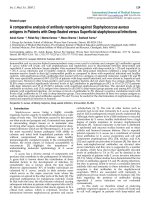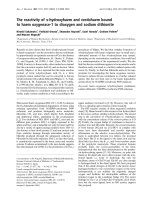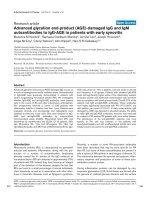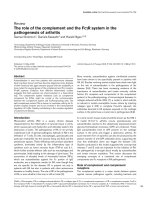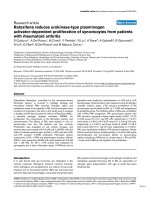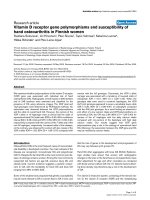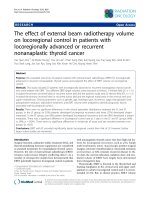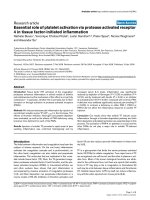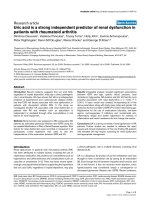Báo cáo y học: "Advanced glycation end-product (AGE)-damaged IgG and IgM autoantibodies to IgG-AGE in patients with early synovitis." ppt
Bạn đang xem bản rút gọn của tài liệu. Xem và tải ngay bản đầy đủ của tài liệu tại đây (90.37 KB, 9 trang )
R82
Introduction
Rheumatoid arthritis (RA) is characterized by persistent
articular and systemic inflammation, along with the pro-
duction of a number of autoantibodies. Antibodies
directed toward the Fc portion of the IgG molecule or
rheumatoid factor (RF) are detected in approximately 70%
of patients with RA. Indeed, they have become an integral
part of the definition of this disease, despite the fact that
RFs are found in a small percentage of normal individuals,
often transiently, as well as in association with other infec-
tious or rheumatic diseases such as Sjögren’s syndrome.
Recently, a number of novel RA-associated antibodies
have been described that may be more specific for RA
than RF, but some of these autoantibodies are present in
only a subset of RA patients in early stages of disease [1].
The relationship between the synovial and systemic inflam-
matory response and production of some of these auto-
antibodies remains unclear.
During inflammation proteins can be damaged by non-
enzymatic glyoxidation [2,3]. Schiff bases are formed after
the glucose or oxidized glucose interacts with the surface
AGE = advanced glycation end-product; APB = aminophenyl boronic acid; CI = confidence interval; ELISA = enzyme-linked immunosorbent assay;
PBS = phosphate-buffered saline; RA = rheumatoid arthritis; RAGE = receptor for advanced glycation end-products; RF = rheumatoid factor; UA =
undifferentiated arthritis.
Arthritis Research & Therapy Vol 5 No 2 Newkirk et al.
Research article
Advanced glycation end-product (AGE)-damaged IgG and IgM
autoantibodies to IgG-AGE in patients with early synovitis
Marianna M Newkirk
1
, Raphaela Goldbach-Mansky
2
, Jennifer Lee
2
, Joseph Hoxworth
2
,
Angie McCoy
2
, Cheryl Yarboro
2
, John Klippel
2
, Hani S El-Gabalawy
2,3
1
McGill University Health Centre, Montreal, Quebec, Canada
2
National Institutes of Arthritis and Musculoskeletal and Skin Diseases, National Institutes of Health, Bethesda, Maryland, USA
3
Current address: University of Manitoba, Winnipeg, Manitoba, Canada
The first two authors contributed equally to this work
Corresponding author: M Newkirk (e-mail )
Received: 18 July 2002 Revisions received: 5 November 2002 Accepted: 21 November 2002 Published: 6 January 2003
Arthritis Res Ther 2003, 5:R82-R90 (DOI 10.1186/ar622)
© 2003 Newkirk et al., licensee BioMed Central Ltd (Print ISSN 1478-6354; Online ISSN 1478-6362). This is an Open Access article: verbatim
copying and redistribution of this article are permitted in all media for any non-commercial purpose, provided this notice is preserved along with the
article's original URL.
Abstract
Advanced glycation end-product (AGE)-damaged IgG occurs as
a result of hyperglycemia and/or oxidative stress. Autoantibodies
to IgG-AGE were previously demonstrated in patients with
severe, longstanding rheumatoid arthritis (RA). We investigated
whether IgG-AGE and anti-IgG-AGE antibodies were present
early in the course of RA and other inflammatory arthropathies.
We prospectively followed a cohort of 238 patients with
inflammatory arthritis of duration less than 1 year. Patients were
evaluated clinically and serologically, and radiographs were
obtained at initial and 1-year visits. Sera were assayed for IgG-
AGE and anti-IgG-AGE antibodies by enzyme-linked
immunosorbent assay (ELISA). Rheumatoid factor (RF) was
determined by nephelometry and ELISA. Of all patients, 29%
had RF-positive RA, 15% had RF-negative RA, 18% had
spondyloarthropathy, and 38% had undifferentiated arthritis. IgG-
AGE was present in 19% of patients, and was similar in amount
and frequency in all groups. Patients with elevated IgG-AGE
levels had significantly higher levels of the inflammatory markers
C-reactive protein and erythrocyte sedimentation rate, but there
was no correlation with blood glucose levels. Overall, 27% of the
patients had IgM anti-IgG-AGE antibodies. These antibodies
were highly significantly associated with RFs (P < 0.0001) and
with swollen joint count (P < 0.01). In early onset arthritis, IgG
damaged by AGE was detected in all patient groups. The ability
to make IgM anti-IgG-AGE antibodies, however, was restricted
to a subset of RF-positive RA patients with more active disease.
The persistence of the anti-IgG-AGE response was more
specific to RA, and was transient in the patients with
spondyloarthropathy and with undifferentiated arthritis who were
initially found to be positive for anti-IgG-AGE antibodies.
Keywords: nonenzymatic glycation, rheumatoid arthritis, rheumatoid factor
Open Access
R82
Available online />R83
accessible ε-amino groups (primarily on lysine and argi-
nine). Subsequently, Amadori rearrangements occur with
the formation of ketoamine and finally the advanced glyca-
tion end-products (AGEs), which are stable. These AGEs
include a large number of chemical structures such as
pentosidine, Nε-(carboxymethly)lysine, pyrraline, and
imadazolone, some of which will cross-link proteins (e.g.
pentosidine, which links a lysine to an arginine on separate
proteins). Hemoglobin-AGE (HbA1c) is the best studied
glycated protein [4] and has been shown to correlate with
both microvascular and macrovascular complications in
diabetic patients. AGE-damaged proteins are increasingly
being implicated in other diseases such as atherosclero-
sis, amyloidosis, aging (in particular, cartilage and the lens
of the eye) [3], and most recently RA [5–10] and
osteoarthritis [10,11]. The cross-links that form in cartilage
due to pentosidine, which cause the typical yellowing
[12], are thought to contribute directly to the joint pathol-
ogy and increases in urinary AGE detected in patients
with osteoarthritis or RA. Such increases may also reflect
cartilage degradation.
Not only cartilage but also antibodies can be damaged
during inflammation. Previous studies have shown that
AGE-damaged IgG can be detected in patients with arthri-
tis of long duration [13–16]. AGE can be detected on
both the heavy and light chains of IgG [13,16,17]. In addi-
tion, our studies indicated not only that IgG-AGE could be
detected in patients with RA, but also that approximately
30–40% of RF-positive patients mounted an immune
response to IgG-AGE. One possible explanation for the
origins of these antibodies and the link to RFs is that RF-
positive B cells could act as antigen-presenting cells for
the damaged IgG and thus stimulate the anti-IgG-AGE
response (analogous to epitope spreading) by other
antigen-selected B cells that express a surface
immunoglobulin specific for the IgG-AGE. In a previous
study of RA patients with longstanding disease [14], the
anti-IgG-AGE antibodies were found to correlate signifi-
cantly with measures of disease activity whereas RFs did
not. It was thus of interest to determine whether the anti-
IgG-AGE response was only a feature of longstanding
inflammation and RF-positive status, or whether such anti-
bodies could be detected in patients with recent onset
disease. Thus, in the present study we sought to deter-
mine whether AGE-damaged IgG could be detected in
patients with early synovitis, and whether this was associ-
ated with an anti-IgG-AGE response.
Our findings indicate that IgG-AGE damage can be
detected in 14–30% of patients with arthritis (RA, a
spondylarthropathy, or undifferentiated arthritis [UA]) of
duration less than 1 year. IgG-AGE was found to correlate
significantly with markers of inflammation but not with
hyperglycemia in these patients. The anti-IgG-AGE
response, in contrast, was found to be much more RA
specific and correlated highly significantly with the ability
to make RFs. In this cohort of patients with early disease,
anti-IgG-AGE was found to correlate significantly with the
swollen joint count and thus appears to be a marker of
disease activity.
Patients and methods
Patients and control individuals
A cohort of 238 patients was recruited from community
physicians to an early synovitis study at the US National
Institutes of Health (protocol 94-AR-194). The referrals
were derived from over 20 different physicians, most of
whom were rheumatologists. All patients had undergone a
preliminary rheumatologic evaluation before study entry.
Inclusion in the study was based on the presence of per-
sistent synovitis in at least one peripheral joint, which had
been present for at least 6 months but less than 1 year.
Patients with traumatic, septic, and crystal-induced arthri-
tis were specifically excluded. Patients with well defined
diffuse connective tissue diseases such as systemic lupus
erythematosus and scleroderma were also excluded.
A tender joint count was determined by assessing for the
presence of joint line and/or stress tenderness in 68
peripheral joints, and a swollen joint count was deter-
mined by evaluating for effusion and/or synovial thickening
in 66 peripheral joints (hips were excluded). The total
number of affected joints was calculated based on the
presence of either tenderness or swelling in each of the
joints examined. Sacroiliitis was defined on the basis of
having a history of persistent inflammatory low back or
buttock pain in conjunction with tenderness over the
sacroiliac joint(s). Radiographic confirmation of sacroiliitis
was sought but was not considered to be an essential
part of the definition. Enthesitis was considered to be
present if the insertion of the Achilles’ tendon or the
plantar fascia was either swollen or tender on examination,
and the patient complained of persistent pain in the hind
foot area.
RF was measured using nephelometry (in which a level
>20 IU/ml was considered positive) and using enzyme-
linked immunosorbent assay (ELISA) as previously
described [13,14]. Anteroposterior and lateral radio-
graphs of the hands, wrists, feet, knees, and other
affected joints were either available for evaluation or were
obtained at the time of assessment. Radiographs were
available for analysis in 196 out of the 238 patients in the
cohort. The radiographs were evaluated for the presence
of erosions by an experienced musculoskeletal radiologist.
Patients were deemed to have an erosive arthropathy if
one or more definite erosions were demonstrable in any
peripheral joint radiograph. No attempt was made to quan-
tify the degree of erosive damage when present. Patients
with clinical evidence of sacroiliitis were evaluated using
anteroposterior and oblique views of the sacroiliac joints.
Arthritis Research & Therapy Vol 5 No 2 Newkirk et al.
R84
The American College of Rheumatology criteria for RA
[18] and the European Spondlyarthropathy Study Group
criteria [19] were applied to each member of the cohort,
based on the clinical, radiographic, and laboratory data
obtained. The European Spondlyarthropathy Study
Group criteria were slightly modified by considering
patients as having an ‘asymmetric’ arthropathy if they did
not meet the American College of Rheumatology symme-
try criterion for RA. Because patients were recruited on
the basis of having peripheral joint synovitis and not axial
disease, the presence of ‘inflammatory spinal pain’, when
present, was insufficient as the only major European
Spondlyarthropathy Study Group criterion. Also, alternat-
ing buttock pain and sacroiliitis were regarded as one
minor criterion rather than two. Patients not fulfilling
either set of criteria were classified as having UA for the
purposes of the present study, even if a more specific
rheumatic diagnosis was suggested clinically. A group of
20 normal individuals (age 32 ± 9.5 years; 14 females
and 6 males) served as a control group, and data from
that group were used to assign a positive cutoff point
only. For the analyses throughout the study, patient
groups were compared with each other, and thus the
lower age of this normal group was not deemed to be a
confounding factor.
Quantification of IgG-AGE in high-molecular-weight
complexes
A solid-phase aminophenyl boronic acid (APB)-ELISA [15]
was used to measure the IgG-AGE in the high-molecular-
weight complexes, which were isolated from serum by a
polyethylene glycol precipitation method. Sera were made
to a 2.5% final concentration with polyethylene glycol
8000 and incubated for 16 hours at 4°C. After centrifuga-
tion at 13 000 g for 15 min, the supernatant was discarded
and the precipitate was resuspended back to the original
serum volume with phosphate-buffered saline (PBS). The
IgG-AGE was measured by ELISA of the AGE proteins
that were captured via cis-diols to the solid-phase immobi-
lized APB. APB (Sigma, Oakville, Ontario, Canada)
2 mg/ml in 0.2 mol/l carbonate/bicarbonate buffer (pH 9.4)
was reacted with Reacti-Bind maleic anhydride activated
polystyrene 96-well plates (Pierce, Rockford, IL, USA) for
16 hours at 37°C. Plates were washed with EPPS buffer
(0.15 mol/l NaCl, 0.02 mol/l EPPS [Sigma], and 0.01 mol/l
MgCl
2
; pH 8.6) three times. The test samples (100 µl)
from the 2.5% polyethylene glycol precipitate (diluted
1/500–1/4000 as necessary to keep the values within the
standard curve), positive and negative controls, and an
appropriate standard curve using IgG
1
-AGE
(0.625–10 µg/ml), all diluted in EPPS buffer and in dupli-
cate, were incubated for 1 hour at 37°C. After washing the
plates three times with PBS/0.1% Tween 20, the plates
were blocked with 100 µl 1% goat serum in PBS/Tween
20 for 1 hour at 37°C. The plates were washed three
times with PBS/Tween 20.
To detect specifically the bound IgG, 100 µl horse radish
peroxidase conjugated F(ab′)
2
fragments of goat antihu-
man IgG (heavy chain specific; Jackson, BioCan, Missis-
sauga, Otario, Canada) diluted 1/20 000 in PBS/Tween
were added and the plates were incubated for 1 hour at
37°C. After washing the plates three times with
PBS/Tween, the substrate o-phenylene diamine was
added. The reaction was stopped by the addition of
4 mol/l H
2
SO
4
approximately 30 min later. The optical
density at 492 nm (reference 690 nm) was measured
using an ELISA plate reader (SLT LabInstruments, Fisher,
Montreal, Quebec, Canada). The plates could be regener-
ated once for reuse by a series of washes. These were, in
sequence, elution of the AGE-modified proteins with
0.1 mol/l sorbitol (American Chemicals Inc., Montreal,
Quebec, Canada; two elutions of 5 min incubation, and
then one rinse at room temperature), and then four
washes with 0.02 mol/l NaOH, followed by five washes
with 0.05 mol/l acetic acid and then 10 washes with dis-
tilled water. Plates were stored between uses in distilled
water containing a bactericidal agent, namely 0.02%
Proclin (Superlco, Sigma). The cutoff for identifying those
with elevated levels of IgG-AGE was the mean plus 2 SD
of IgG-AGE levels from 20 normal individuals.
Measurement of antibodies to IgG-AGE
IgM and IgA anti-IgG-AGE antibodies were detected in
serum or plasma by ELISA, as previously described
[13,14], with the testing laboratory being blinded to the
diagnosis. IgG of all four subclasses, which were fully gly-
cated in vitro, were used at a concentration of 2 µg/ml to
coat the wells of an enzyme immunoassay plate (ICN,
Montreal, Quebec, Canada). After washing the plates, the
sera or plasma, diluted 1:1000 in duplicate, were incu-
bated in the AGE-modified immunoglobulin-coated wells
for 2 hours at 37°C. After washing the plates in
PBS/Tween (0.1%), the bound antibodies were detected
using peroxidase conjugated F(ab′)2 fragments of anti-
human IgM, or IgA (Jackson) diluted 1/10 000 in
PBS/Tween. To follow the reactivity over time, and keep
consistent results, serum from one normal individual
(approximating the mean reactivity) and a positive control
was tested each time the assay was performed. After
washing the plates three times with PBS/Tween, the sub-
strate o-phenylene diamine was added. The reaction was
stopped by the addition of 4M H
2
SO
4
approximately
30 min later. The optical density at 492 nm (reference
690 nm) was measured, using an ELISA plate reader (SLT
LabInstruments). Cutoff values were determined from the
sera of 20 normal control individuals, and were the mean
plus 2 SD. In order to standardize the optical densities
over time, the experimental values obtained were cor-
rected to the positive control that was included in every
assay. For selected sera, the titers for reactivity against the
IgG-AGE as well as against bovine serum albumin with
and without AGE damage were determined.
Because IgG
1
, IgG
2
, and IgG
4
are structurally very similar,
and in general when a sera was positive against IgG
1
-
AGE it was also reactive against IgG
2
-AGE as well as
IgG
4
-AGE, for clarity only the results for the response to
IgG
1
-AGE are presented. Because IgG
3
is structurally
quite different (60 amino acid long hinge region versus the
12–15 amino acid hinge in IgG
1
, IgG
2
, and IgG
4
, along
with several other differences in the heavy chain), the data
for the immune response to IgG
3
-AGE are also presented.
In preliminary studies (not shown), investigations into the
specificity of the assay for RFs were done. Sera contain-
ing RF and anti-IgG-AGE antibodies were preincubated
with either an AGE [Nε-(carboxymethly)lysine] or IgG
(which lacked AGE damage) to see if the reactivity could
be blocked in the subsequent ELISA. We found that IgG
at 1 mg/ml inhibited 30% of the binding of polyclonal RF
from one patient with RA to IgG, but it did not inhibit the
binding of polyclonal anti-IgG-AGE antibodies to IgG-
AGE. Higher concentrations of IgG (4 mg/ml) inhibited the
binding of polyclonal RF by up to 90%, and anti-IgG-AGE
by 30%, but this could have been because the polyclonal
IgG might have had AGE on it. Preincubation with Nε-(car-
boxymethly)lysine (50 mg/ml) inhibited the binding of poly-
clonal anti-IgG-AGE antibodies to IgG-AGE by 40% but
did not inhibit RF binding to IgG. Lysine at the same con-
centration did not inhibit either. Thus, this assay appears
to measure anti-IgG-AGE antibodies and not simply RFs.
Statistical analysis
Patient groups were compared using analysis of variance
or the Kruskal–Wallis test for continuous variables, and
using the χ
2
test for proportions. The significance levels
were adjusted for multiple comparisons using the Bonfer-
roni method where applicable. Statistical analyses were
performed using Epi Info statistical software (Centers for
Disease Control and Prevention, Atlanta, GA, USA;
and SPSS sta-
tistical software (SPSS Inc., Chicago, IL, USA).
Results
The clinical characteristics of the early synovitis patients
are shown in Table 1. A total of 105 patients met the
American College of Rheumatology criteria for RA. Of the
patients meeting American College of Rheumatology crite-
ria, 69 (66%) were IgM RF positive by nephelometry. Only
10 patients (all with RA) were found to be positive for IgA
RFs. Because so few of the cohort members were positive
for IgA RFs, no meaningful comparisons were possible
with respect to disease parameters, and thus the focus of
the present study was on the IgM RF response. A total of
43 patients met the European Spondlyarthropathy Study
Group criteria for spondylarthropathy, whereas
90 patients had UA. Females predominated in all groups,
ranging from 61% to 73% of the groups. The patients with
RA were significantly older than the spondylarthropathy
and UA groups. Within the spondylarthropathy group a
number of patients with a reactive self-limiting arthritis
were identified, but there were also a number of patients
with multiple joint involvement that persisted and who
were on steroids, thus accounting for the prednisone use
in 26%. These patients with multiple joint involvement
could be thought of as having ‘undifferentiated spondyl-
arthropathies’ who did not fit the picture of a reactive type
of arthritis.
Available online />R85
Table 1
Demographic and clinical characteristics of patients with early synovitis at initial visit
Patient group
Characteristic RF
+
RA (n = 69) RF
–
RA (n = 36) SpA (n = 43) UA (n = 90)
Caucasian (%) 77 85 94 82
Females (n) 43 (61%) 27 (73%) 27 (63%) 60 (67%)
Age (years) 47 ± 12*
†
43±15 38±11* 41±14
†
Symptom duration (weeks) 32 ± 18 29 ± 26 45 ± 59 29 ± 19
Swollen joint count 13 ± 9 14 ± 10 2 ± 2 3± 4
Total affected joint count 19± 12 19± 11 5± 11 5± 7
ESR (mm/hour) 44 ± 27 46 ±33 36 ±30 34 ±29
CRP (mg/dl) 1.8 ± 1.8 2.1 ± 2.2 1.9 ± 3.0 1.7 ± 2.2
Hemoglobin (mg/dl) 13 ± 1.5 13 ± 1.7 13 ± 1.4 13 ± 1.6
Glucose (mg/dl) 109 ± 53 99 ± 19 99 ± 35 97 ± 30
DMARD therapy (%) 41 39 19 12
Prednisone therapy (%) 36 44 26 11
Values are expressed as mean ± SD, unless otherwise stated. *P < 0.001,
†
P < 0.05, versus like symbols by analysis of variance or χ
2
test, with
Yates correction where appropriate. CRP, C-reactive protein; DMARD, disease-modifying antirheumatic drug; ESR, erythrocyte sedimentation rate;
RA, rheumatoid arthritis; RF, rheumatoid factor; SpA, spondyloarthropathy; UA, undifferentiated arthritis.
Detection of AGE-damaged IgG in the early synovitis
patients
As can be seen from Tables 2 and 3, the IgG-AGE levels
were higher in the RA patient group at the initial visit as
compared with the other groups studied, whereas the
levels were similar in all groups at the year 1 follow-up
visit. For both time points, 14–28% of the patients were
found to have elevated levels of IgG-AGE. There was a
trend for the IgG-AGE amounts to increase in the spondyl-
arthropathy group and, conversely, fall slightly in the RA
group at the second visit. This may reflect the lower use of
prednisone in the spondylarthropathy patients during the
period between visits (Table 4). Interestingly, the patients
with elevated IgG-AGE levels were found to have signifi-
cantly increased levels of the inflammation markers ery-
throcyte sedimentation rate and C-reactive protein
(Table 5). The odds ratio for the association between ele-
vated IgG-AGE positive status and erythrocyte sedimenta-
tion rate greater than 50 mm/hour for all 238 patients was
2.45 (95% confidence interval [CI] 1.22–4.96; P = 0094)
and for the 105 RA patients it was 3.19 (95% CI
1.13–9.12; P = 0.0024). There was no correlation
between IgG-AGE and glucose levels, indicating that it is
inflammation and not hyperglycemia that exerts the major
influence on AGE formation in the patients with early syn-
ovitis. IgG damaged by AGE was found to be associated
with total IgG level (r = 0.209; P = 0.0028), although the r
value was very low.
Antibodies to IgG-AGE
As can be seen in Fig. 1, and Tables 3 and 5, antibodies to
IgG-AGE were detected in patients primarily with RA. This
specificity varied according to the target subclass of IgG,
with the immune response higher in the majority of cases
to IgG
1
(and thus IgG
2
and IgG
4
) than to IgG
3
(Fig. 1), and
for the representative sera illustrated no reactivity was
detected against either BSA or BSA-AGE. Antibodies
specific for AGE-damaged IgG
1
or IgG
3
were found in
11–40% of patients in the different groups, and were
highly significantly associated (P < 0.0001) with the pres-
ence of RFs (Tables 3 and 5), with odds ratios of 7.32
(95% CI 3.68–14.67) for all the 238 patients and 9.54
(95% CI 2.77–36.12) for the 105 RA patients. Nonethe-
less, this immune response to damaged IgG was not
simply a reflection of the titer of RF because at the initial
visit 10 patients (all with RA) had high-titer RF but lacked
the anti-IgG-AGE response. At the year 1 follow-up visit,
eight patients (all with RA) were found to have a high-titer
RF response but no detectable anti-IgG-AGE response.
There was a highly significant association between RF
positivity by nephelometry and that by ELISA (odds ratio
44.56, 95% CI 17.98–114.51; P < 0.00001). Of those
RA patients who were RF positive by nephelometry,
35 out of 69 had antibodies to either IgG
1
-AGE and/or
IgG
3
-AGE. Our previous studies showed that approxi-
mately 50% of RF-positive patients with longstanding
disease were anti-IgG-AGE positive [14]. Thus, this sub-
population appears to be fairly consistent over time.
Interestingly, as shown in Fig. 2, the anti-IgG-AGE antibod-
ies response persisted in the RF-positive RA patients at
Arthritis Research & Therapy Vol 5 No 2 Newkirk et al.
R86
Table 2
AGE-IgG amounts (in relative units) in patients with early
synovitis at initial visit and at 1-year follow up
Patient AGE-IgG at AGE-IgG at
group n initial visit 1-year follow up
RA 106 2.94 ± 3.37*
†
2.41 ± 2.38
SpA 43 1.82 ± 1.18* 2.46 ± 2.39
UA 90 1.89 ± 1.52
†
2.18 ± 1.88
Normal 20 1.57 ± 0.74
*P < 0.05,
†
P < 0.05, versus like symbols by nonparametric, Dunn’s
multiple comparison test. AGE, advanced glycation end-product; RA,
rheumatoid arthritis; RF, rheumatoid factor; SpA, spondyloarthropathy;
UA, undifferentiated arthritis.
Table 3
Number positive and frequency for AGE-IgG, rheumatoid factor, and anti-AGE-IgG antibodies in the patient groups at initial visit
Patient group
Serum finding RF
+
RA (n = 70) RF
–
RA (n = 36) SpA (n = 36) UA (n = 89) Normal (n = 20)
AGE-IgG
+
14 (20%) 11 (31%) 9 (25%) 13 (15%) 1(5%)
IgM RF
+
(by nephlometry) 70 (100%)* 0 2 (6%) 16 (18%) NA
IgM RF
+
(by ELISA) 64 (91%)*
1
6 (17%)
2
6 (17%) 22 (25%) 1(5%)
Anti-AGE-IgG
1
+
27 (39%)* 5 (14%) 4 (11%) 15 (17%) 0
Anti-AGE-IgG
3
+
28 (40%)* 4 (11%) 4 (11%) 14 (16%) 0
1
Fifty-four out of 66 (82%) were rheumatoid factor (RF) positive at the year 1 follow up;
2
2 out of 34 (6%) remained RF positive at the year 1
follow-up. *P < 0.05, between patient groups by analysis of variance or χ
2
test, with Yates correction where appropriate. ELISA, enzyme-linked
immunosorbent assay; NA, not available; RA, rheumatoid arthritis; SpA, spondyloarthropathy; UA, undifferentiated arthritis.
follow up, whereas those positive for anti-IgG-AGE anti-
bodies in the other groups had lower frequencies of such
antibodies at the year 1 follow up. When the change in the
anti-IgG-AGE response was examined (Table 6), it was
apparent that only in the RF-positive RA group was there a
subset of patients (approximately 20%) who not only had
gained this immune response by the year 1 follow-up visit
but also maintained it. In contrast in the spondylarthropa-
thy and UA groups, the initial positive anti-IgG-AGE
response was lost at follow up. Thus, the anti-IgG-AGE
response appears much more specific to RF-positive RA.
Of the clinical features examined, only the swollen joint
count was found to be associated with anti-IgG-AGE anti-
bodies (Table 5). When patients with and without anti-
IgG-AGE antibodies were examined for erosions at the
year 1 follow-up visit, there was trend toward more erosive
disease in the anti-IgG-AGE group, but this was not statis-
tically significant (data not shown). Anti-IgG-AGE antibod-
ies were found to be associated with IgA levels (r = 0.304;
P = 0.02) for reasons that are as yet unknown.
Discussion
Previous studies of AGE in RA have been cross-sectional
in nature and in general conducted in patients with
disease of several to many years duration. Thus, it was
important to examine a cohort of patients with early synovi-
tis to determine whether AGE-damaged proteins were
present near disease onset, in order to determine whether
the generation of AGEs could be linked to an ongoing
Available online />R87
Table 4
Disease-modifying antirheumatic drug and prednisone use in the early synovitis patients at initial visit and year 1 follow up
Patient group DMARD at initial visit DMARD at year 1 follow up Prednisone at initial visit Prednisone at year 1 follow up
RF
+
RA 28/69 (41%) 46/67 (86%) 25/69 (36%) 25/67 (37%)
RF
–
RA 14/36 (39%) 27/34 (79%) 16/36 (44%) 17/36 (50%)
SpA 8/43 (19%) 10/37 (29%) 11/43 (26%) 3/37 (8%)
UA 11/90 (12%) 18/79 (23%) 10/90 (11%) 9/79 (23%)
Values are expressed as number taking/total (%). DMARD, disease-modifying antirheumatic drug; RA, rheumatoid arthritis; RF, rheumatoid factor;
SpA, spondyloarthropathy; UA, undifferentiated arthritis.
Table 5
AGE-IgG is associated with the inflammatory response, whereas anti-AGE-IgG is associated with rheumatoid factor positive
rheumatoid arthritis in the early synovitis cohort at the initial visit
Serum finding
Characteristic IgG-AGE
+
(n = 47) IgG-AGE
–
(n = 191) Anti-IgG-AGE
+
(n = 65) anti-IgG-AGE
–
(n = 173)
Females (%) 55 68 71 64
Age (years) 39 ± 12 43 ± 14 41 ± 13 43 ± 14
Swollen joint count 8.2± 8.7 7.2 ± 8.9 11.0 ± 11* 6.2 ± 7.6
ESR (mm/hour) 51 ± 38* 36 ± 27 45 ± 30 37 ± 30
CRP (md/dl) 2.5 ± 3.1* 1.5 ± 1.8 1.7 ± 2.0 1.8 ± 2.3
Hemoglobin (mg/dl) 13.0 ± 1.9 12.5 ± 1.5 12.7 ± 1.5 12.9 ± 1.6
Glucose (mg/dl) 100 ± 30 102 ± 40 99 ± 25 102 ± 42
IgG (mg/dl) 1427 ± 529* 1182 ± 378 1252 ± 369 1226 ± 443
IgM (mg/dl) 139 ± 61 152 ± 88 173 ± 61* 140 ± 88
IgA (mg/dl) 285 ± 139 236 ± 104 282 ± 126 232 ± 106
RF
+
(%) 19 (40%) 69 (36%) 45 (69%)* 25%
Anti-AGE-IgG
1
+
(n) 18 (26%) 40 (21%) 50 (77%) –
Anti-AGE-IgG
3
+
(n) 12 (26%) 38 (20%) 49 (76%) –
Values are expressed as means ± SD, unless otherwise stated. *P < 0.05, by analysis of variance or χ
2
test, with Yates correction where
appropriate; comparisons are between AGE-IgG
+
and AGE-IgG
–
patients, and between anti-AGE-IgG
+
and anti-AGE-IgG
–
patients. AGE,
advanced glycation end-product; CRP, C-reactive protein; ESR, erythrocyte sedimentation rate; RF, rheumatoid factor.
Arthritis Research & Therapy Vol 5 No 2 Newkirk et al.
R88
pathogenic process or whether they are merely the conse-
quence of damage in the past. The amount of AGE-
damaged proteins present in an individual reflects not only
the synthesis of the AGE, which can take weeks to
months, but also the clearance of the AGE-damaged
protein either through normal mechanisms for the protein
in question or by specific receptors for AGE, one of which
is termed receptor for AGE (RAGE) [20]. The present
study shows that the formation of AGE-damaged IgG in
this early synovitis cohort is linked to the inflammatory
response rather than to hyperglycemia. The latter is key in
the AGE associated with diabetes [3]. We did not
measure hemoglobin A1c in the present study, but in a
previous study it was not found to correlate with IgG-AGE
in patients with longstanding RA [14]. Thus, it appears
that AGE formation associated with arthritis occurs as a
result of oxidative stress. Recent studies have shown that
high levels of RAGE expression, which is induced by AGE,
can contribute to the inflammatory cycle by the induction
of proinflammatory cytokines, via the nuclear factor-κB
pathway [21]. No studies have yet examined RAGE
expression in the synovium of patients with early synovitis.
RAGE appears to play a central role in the arthralgia asso-
ciated with AGE-modified β
2
-microglobulin, the latter
being a consequence of long-term dialysis [22].
From our studies, the presence of IgG damaged by AGE is
not disease specific but occurs in all forms of arthritis, and
importantly at an early stage of disease. Approximately
15–30% of the patients had elevated levels of IgG-AGE at
their initial visit, and the levels were seen to fluctuate over
time because there was no correlation between the amounts
of IgG-AGE at the initial and the year 1 follow-up visits. The
frequency and levels of IgG-AGE were slightly higher than
we previously observed in patients with longstanding
disease [14]. Elevations in pentosidine (a specific type of
AGE) were previously found to correlate with increased clini-
cal disease activity in RA and with RF levels [6–11].
However, in the present study no clinical parameter of joint
disease was found to correlate with levels of IgG-AGE.
Figure 1
IgM antibodies directed at IgG
1
-advanced glycation end-product
(AGE) or IgG
3
-AGE in two patients with rheumatoid arthritis (RA)
when sera were diluted 1/1000–1/8000: ᭜, RA1 anti-IgG
1
-AGE;
, RA2 anti-IgG
1
-AGE; ᭝, RA1 anti-IgG
3
-AGE; ᭺, RA2 anti-IgG
3
-
AGE. Binding to bovine serum albumin (BSA) for RA1 and RA2 (sera
diluted 1/500) was 0.031 and 0.078, respectively, and for BSA-AGE
for RA1 and RA2 (sera diluted 1/500) 0.029 and 0.025, respectively.
OD, optical density.
0
0.2
0.4
0.6
0.8
1
1.2
1.4
1000 2000 4000 8000
Serum dilution
OD 492
Figure 2
Anti-IgG-advanced glycation end-product (AGE) antibodies persist in
rheumatoid factor (RF)-positive rheumatoid arthritis (RA), whereas they
are more transient in the other groups of patients with early synovitis.
SpA, spondyloarthropathy; UA, undifferentiated arthritis.
0
10
20
30
40
50
60
Initial visit Year-1 follow up
% Anti-IgG-AGE positive
RF+RA
RF-RA
SpA
UA
Table 6
Change in the anti-IgG-AGE response from initial visit to follow up in the early synovitis cohort
Always Positive at initial assessment; Negative at initial assessment;
Patient group n negative negative at follow up positive at follow up Always positive
RA RF
+
68 22 (32%) 17 (25%) 15 (22%) 14 (21%)
RA RF
–
35 32 (91%) 1 (3%) 0 (0%) 2 (6%)
SpA 38 32 (84%) 5 (13%) 1 (3%) 0 (0%)
UA 75 64 (85%) 8 (11%) 1 (2%) 2 (3%)
Values are expressed as n (%), unless otherwise stated. AGE, advanced glycation end-product; RA, rheumatoid arthritis; RF, rheumatoid factor;
SpA, spondyloarthropathy; UA, undifferentiated arthritis.
Our previous studies found a subset of RA patients with
longstanding disease to have antibodies to IgG-AGE [14].
In the present study we extend this observation to patients
with early synovitis. Consistent with previous studies, the
ability to make anti-IgG-AGE antibodies was strongly
linked to RF-positive status. A mechanism that may
account for this is that RF-positive B cells might play a role
in antigen presentation of the IgG-AGE and in induction of
the immune response to AGEs. This would be analogous
to the process of epitope spreading. Recent studies
employing mass spectrometry have shown that much of
the AGE on IgG is located within the Fab region [17],
which would not interfere with the binding of the Fc
portion of IgG to the RF.
In contrast to the IgG-AGE elevations, which were not
found to be disease specific, the anti-IgG-AGE response
was much more specific to RA, and in particular to
RF-positive RA. Indeed, at the initial visit, whereas a small
percentage of patients with UA or spondyloarthropathy
were found to have anti-IgG-AGE antibodies, this immune
response appeared to be largely transient in these groups
only, with the loss of this specificity by the year 1 follow-up
visit. In contrast, in the RF-positive RA group, not only did
approximately 20% gain this specificity at the year 1
follow-up visit (versus 0–3% in the other groups) but also
a much higher proportion maintained this specificity at
follow up than in any other group. Thus, the anti-IgG-AGE
response is much more specific to RF-positive RA.
In the overall cohort, the anti-IgG-AGE response was
associated with the swollen joint count, which probably
reflects the increased joint count seen in RA, because
within RA there was no significant correlation noted in
these patients with early synovitis. In our previous study in
patients with longstanding disease [14], there was a sig-
nificant correlation between the anti-IgG-AGE response
and swollen joint count, whereas the RF response was not
a useful biomarker for current disease activity. In the latter
study the anti-IgG-AGE response was also linked to a
physician-assessed disease activity score (visual analogue
score). The latter type of evaluation was not conducted
with the early synovitis cohort. Nonetheless, it does
appear that, with respect to current disease activity, the
level of anti-IgG-AGE antibodies represents a useful bio-
marker. RFs detected in other early synovitis cohorts have
been shown to be predictive of long-term radiologic
damage [23–25], and thus it will be of interest to follow
this cohort over time to determine whether the anti-IgG-
AGE antibodies will also be predictive of more severe
disease in this subset of RA patients.
Conclusion
In early onset arthritis, IgG damaged by AGE, as a result
of inflammation, was detected in all patient groups. The
ability to make anti-IgG-AGE antibodies, however, was
restricted to a subset of RF-positive RA patients with more
active disease. The persistence of the anti-IgG-AGE
response was found to be more specific to RA and was
transient in the patients with spondyloarthropathy or UA
who were initially found to be positive for anti-IgG-AGE
antibodies. These studies demonstrated that this immune
response to IgG-AGE occurs early in RA pathogenesis,
and give important insight into the consequences of
inflammation in this disease setting.
Competing interests
None declared.
Acknowledgements
The authors would like to thank Dr H Ralph Schumacher for his invalu-
able contributions to this study, and Dr Gabor Illei for critical reading of
the manuscript. Supported in part from a NIAMS Intramural Research
Program.
References
1. Goldbach-Mansky R, Lee J, McCoy A, Hoxworth J, Yarboro C,
Smolen JS, Steiner G, Rosen A, Zhang C, Menard HA, Zhou ZJ,
Palosuo T, Van Venrooij WJ, Wilder RL, Klippel JH, Schumacher
HR Jr, EI-Gabalawy HS: Rheumatoid arthritis associated
autoantibodies in patients with synovitis of recent onset.
Arthritis Res 2000, 2:236-243.
2. Singh R, Barden A, Mori T, Beilin L: Advanced glycation end-
products: a review. Diabetologia 2001, 44:129-146.
3. Ulrich P, Cerami A: Protein glycation, diabetes, and aging.
Recent Prog Horm Res 2001, 56:1-21.
4. Makita Z, Vlassara H, Rayfield E, Cartwright K, Friedman E, Rodby
R, Cerami A, Bucala R: Hemoglobin-AGE: a circulating marker
of advanced glycosylation. Science 1992, 258:651-653.
5. Chen JR, S Takahashi, M Suzuki, K Kushida, S Miyamoto, Inoue T:
Pentosidine in synovial fluid in osteoarthritis and rheumatoid
arthritis: relationship with disease activity in rheumatoid
arthritis. J Rheumatol 1998, 25:2440-2444.
6. Furumitsu Y, Inaba M, Yukioka K, Yukioka M, Kumeda Y, Azuma Y,
Ohta T, Ochi T, Nishizawa Y, Morii H: Levels of serum and syn-
ovial fluid pyridinium crosslinks in patients with rheumatoid
arthritis. J Rheumatol 2000, 27:64-70.
7. Miyata T, Ishiguro N, Yasuda Y, Ito T, Nangaku M, Iwata H,
Kurokawa K: Increased pentosidine, an advanced glycation
end product, in plasma and synovial fluid from patients with
rheumatoid arthritis and its relation with inflammatory
markers. Biochem Biophys Res Comm 1998, 244:45-49.
8. Rodriquez-Garcia J, Requena JR, Rodriguez-Segade R:
Increased concentrations of serum pentosidine in rheumatoid
arthritis. Clin Chem 1998, 44:250-255.
9. Takahashi M, Suzuki M, Kushida K, Miyamoto S, Inoue T: Rela-
tionship between pentosidine levels in serum and urine and
activity in rheumatoid arthritis. Br J Rheum 1997, 36:637-642.
10. Torchiana EEM, Murgo A, Re KA, Paresce E, DeGiovanni R,
Sansone L, Carrabba M: Pyridinium crosslinks in osteoarthritis
and rheumatoid arthritis: a predictive factor? [abstract]. J
Rheumatol 1998, 25(suppl 52):42.
11. Pokharna HK, Monnier V, Boja B, Moskowitz RW: Lysyl oxidase
and Maillard reaction-mediated cross-links in ageing and
osteoarthritic rabbit cartilage. J Bone Joint Res 1995, 13:13-21.
12. Monnier VM, Kohn RR, Cerami A: Accelerated age-related
browning of human collagen in diabetes mellitus. Proc Natl
Acad Sci USA 1984, 81:583-587.
13. Ligier S, Fortin PR, Newkirk MM: A new antibody in rheumatoid
arthritis (RA) targeting glycated IgG: IgM anti-IgG-AGE. Br J
Rheumatol 1998, 37:1307-1314.
14. Lucey M, MM Newkirk,
Neville C, Lepage K, Fortin PR: Associa-
tion between IgM-anti-IgG-AGE autoantibody and disease
activity in rheumatoid arthritis. J Rheumatol 2000, 27:319-323.
15. Newkirk MM, Lepage K, Niwa T, Rubin L: Advanced glycation
endproducts (AGE) on IgG, a target for circulating antibodies
in North American Indians with Rheumatoid Arthritis (RA). Cell
Molec Biol 1998, 44:1129-1138.
Available online />R89
16. Tai W-H, Newkirk MM: An autoantibody targeting glycated IgG is
associated with elevated serum immune complexes in
rheumatoid arthritis (RA). Clin Exp Immunol 2000, 120:188-193.
17. Lapolla A, Fedele D, Garbeglio M, Martano L, Tonani R, Seraglia
R, Favretto D, Fedrigo MA, Traldi P: Matrix-assisted laser des-
orption/ionization mass spectrometry, enzymatic digestion,
and molecular modeling in the study of nonenzymatic glyca-
tion of IgG. J Am Soc Mass Spectrom 2000, 11:153-159.
18. Arnett FC, Edworthy SM, Bloch DA, McShane DJ, Fries JF,
Cooper NS, Healey LA, Kaplan SR, Liang MH, Luthra HS, et al.:
The American Rheumatism Association 1987 revised criteria
for the classification of rheumatoid arthritis. Arthritis Rheum
1988, 31:315-324.
19. Dougados M, van der Linden S, Juhlin R, Huitfeldt B, Amor B,
Calin A, Cats A, Dijkmans B, Olivieri I, Pasero G, et al.: The Euro-
pean Spondylarthropathy Study Group preliminary criteria for
the classification of spondylarthropathy. Arthritis Rheum 1991,
34:1218-1227.
20. Schmidt AM, Hofmann M, Taguchi A, Yan SD, Stern DM: RAGE:
a multiligand receptor contributing to the cellular response in
diabetic vasculopathy and inflammation. Semin Thromb
Hemost 2000, 26:485-493.
21. Yeh CH, Sturgis L, Haidacher J, Zhang XN, Sherwood SJ, Bjercke
RJ, Juhasz O, Crow MT, Tilton RG, Denner L: Requirement for
p38 and p44/p42 mitogen-activated protein kinases in RAGE-
mediated nuclear factor-kappaB transcriptional activation and
cytokine secretion. Diabetes 2001, 50:1495-1504.
22. Hou FF, Reddan DN, Seng WK, Owen WF Jr: Pathogenesis of
beta(2)-microglobulin amyloidosis: role of monocytes/
macrophages. Semin Dial 2001, 14:135-139.
23. Kaltenhauser S, Wagner U, Schuster E, Wassmuth R, Arnold S,
Seidel W, Troltzsch M, Loeffler M, Hantzschel H: Immunogenetic
markers and seropositivity predict radiological progression in
early rheumatoid arthritis independent of disease activity. J
Rheumatol 2001, 28:735-744.
24. Rau R, Herborn G, Zueger S, Fenner H: The effect of HLA-DRB1
genes, rheumatoid factor, and treatment on radiographic
disease progression in rheumatoid arthritis over 6 years. J
Rheumatol 2000, 27:2566-2575.
25. Aman S, Paimela L, Leirisalo-Repo M, Risteli J, Kautiainen H,
Helve T, Hakala M: Prediction of disease progression in early
rheumatoid arthritis by ICTP, RF and CRP. A comparative 3-
year follow-up study. Rheumatology 2000, 39:1009-1013.
Correspondence
M Newkirk, The Montreal General Hospital, 1650 Cedar Ave., Mon-
treal, QC. H3G 1A4 Canada. Tel: +1 514 934 1934 ext. 44075; fax:
+1 514 934 8239; e-mail
Arthritis Research & Therapy Vol 5 No 2 Newkirk et al.
R90
